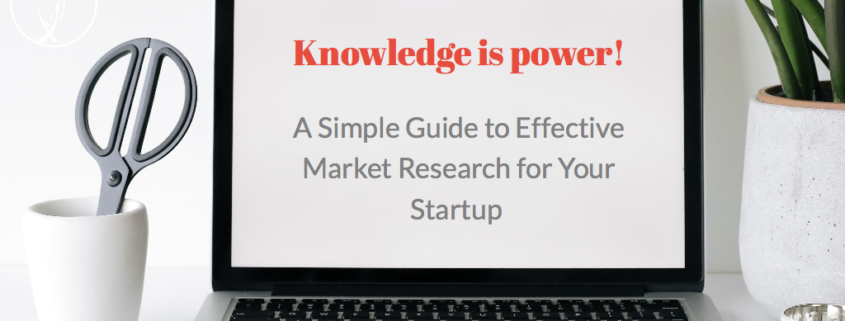A Simple Guide to Effective Market Research for Your Startup — Lionesses of Africa

By Farida Yahya
For any business to succeed, especially a new one making its way into the market, it must be armed with accurate and detailed information. After all, “Knowledge is power!” With the knowledge gleaned from the market research, it provides the entrepreneur with a wealth of information about prospective and existing customers, the competition, and the industry in general. It allows you to determine the feasibility of a business before committing your resources to the venture.
Market research provides the necessary data needed to help a company solve its marketing problems. Did you know that marketing/sales strategies such as market segmentation (identification of specific groups within a market) and product differentiation (creating an identity for your product or service to make it stand out from your competitors) cannot be developed without (thorough) market research?
There are many ways to conduct market research in order to map out clear insights and understand your customers. However, this my simple guide to doing it, and I would like to highlight how to identify your buyer persona and choose which buyers to survey as the pivotal parts of a survey.
Identify/Define Your Buyer Persona
Who is your buyer? What is their persona? Before you start identifying what characteristics influences your customers’ purchasing decisions, you must first understand who they are. This should be the first exercise carried out when conducting your primary market research. The following are major characteristics that must be included when making up the components of who your ideal customers should be:
-
Age
-
Gender
-
Location
-
Job title(s)
-
Family size
-
Income
-
Values/Personal beliefs
-
Major challenges
The idea behind this list is to use it as a guideline or map when you finally reach and learn about actual customers in your industry.
Engage With A Small Segment Of That Persona
Now that you’ve identified your buyer personas, the next step is to follow-up with them. How do you do this? Find a representative sample of your target customers. These people would give you all the information you need about their characteristics, challenges, and buying habits.
To get this right, ensure that they’re people who recently made a purchase (or purposefully decided not to make one), and you can meet with them via the following ways:
Compile Your Research Questions
There is no better way to make sure that you get the most of your survey than to be prepared. As a rule of the thumb, create a discussion guide (it could be for a focus group, online survey, or a phone interview). The key here is to ensure that you cover all of the top-of-mind questions and use your time wisely.
Please note that while I mentioned that your questions should touch all the necessary bases; however, it shouldn’t be a script. It shouldn’t be forced or feel awkward. The discussion should feel natural and conversational, so it’ll encourage participants to participate.
Identify Your Major Competitors
Understanding your competitors begins your secondary market research. But keep in mind that competition isn’t always as simple as Company X versus Company Y.
Sometimes, a division of a company might compete with your main product or service, even though that company’s brand might put more effort in another area.
For example, you could be a fashion retail company and a fashion blogger might be a competitor. Or from a content standpoint, you might compete with a blog, YouTube channel, or similar publication for inbound website visitors – even though their products don’t interfere with yours at all. Even while these people don’t sell or make what you produce, they’re your competitors (indirect) as well.
Compile Your Findings Into A Summary
If you feel overwhelmed about the amount of information you’ve culled, you’re not alone. Here’s what you can do to make the process easier. Simply summarize your findings!
Here’s how: You can use your favourite presentation software to make a report. Feel free to add in quotes and diagrams. While you can let your creativity run its course, ensure that your summary follows this outline below:
-
Background. Your business’ goals and why the study was conducted.
-
Participants. The participants you recruited. You can create a table to break groups down by persona and customer/prospect.
-
Executive Summary. Detail the interesting things you’ve learnt during the study. Also, explain your plans as regards the information you discovered.
-
Awareness. Describe the common triggers that lead someone to enter into an evaluation. Feel free to throw in some quotes. They add more power to the text.
-
Consideration. Identify the main themes you uncovered, as well as the detailed sources buyers use when conducting their evaluation.
-
Decision. Describe vividly about how a purchasing decision is really made by including the people at the center of influence and any product features or information that can make or break a deal.
-
Action Plan. Describe/provide the strategies you intend to use to get your product or service in front of buyers and/or more effectively. Provide your list of priorities, a timeline, and the impact it will have on your business.
Remember, conducting market research can be very enlightening. You’d be amazed to discover a new wealth of information you had no idea about. Never assume that you know your buyers so well. And even if you think you know your buyers pretty well, conducting market research will help identify your flaws, show you the places you’re doing it right and give you tips on how to make your business better.




Leave a Reply
Want to join the discussion?Feel free to contribute!